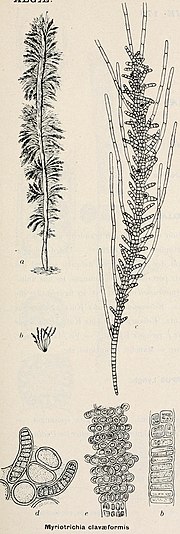|
Myriotrichia
Myriotrichia is a genus of brown algae.[3] It forms small, soft, olive-brown tufts on the surface of other plants. Filaments rarely exceed centimetres in length.[4]: 105 It may grow by intercalary growth.[4]: 105 Its sporangia may contain one or many cavities, and emerge directly from the surface cells; they may form a ring around the main nema.[4]: 105 Dedicated photosynthetic machinery may be entirely absent.[4]: 107 Its life history consists of alternation of phases; it has isogamous gametes, and dioecious gametophytes.[5] At warm temperatures 18 °C (64 °F), the alga reproduces sexually, forming single chambered "meiosporangia". At cooler temperatures, asexual reproduction took place in multi-chambered "mitosporangia".[5] The gametophyte phase only produces gametes when day length is long; with shorter days these too reproduce asexually.[5] This is probably because the plants upon which they are epiphytic only grow in the spring.[6] The gametophyte is filamentous – while the sporophyte bears parenchyma, even though it only reaches around 4 cm (2 in) in length.[5] The alga has a small genome with approximately 12 chromosomes.[5] References
|
||||||||||||||||||||||||||||||||||||
